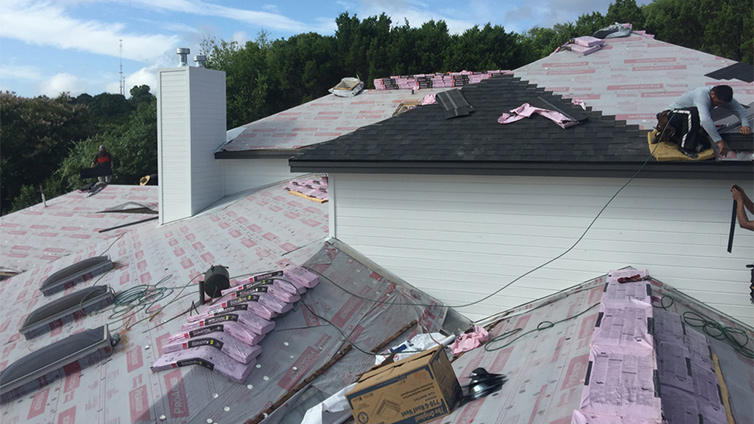Roofing Underlayment—How This Essential Roofing Element Protects Your Home
If you’re a homeowner, you’re likely well versed in the multiple ways a roofing system protects you and your family. It’s the first line of defense against Mother Nature and the other factors that could harm you and your possessions. In addition, roofs also add a key structural element to your home, protecting your attic space and allowing the crucial ventilation that helps keep your home healthy and the essential insulation that keeps the interior of your house cool and comfortable year-round.
However, did you know that some of the essential elements of your roofing system lie beneath the visible shingle layer? While their contributions often go unappreciated, these layers help to keep other layers of your roof dry, protecting the interior of your home from moisture and other elements. To understand how it’s important to get a more detailed picture of how your roof is constructed.
How Your Roof Works
Your roof exists in a variety of layers, each with its own purpose to maintain the integrity and protective barrier provided the roofing system. Depending on your home’s design and type of construction, the lower layers of your roofing system usually consist of:
- A skeleton — usually constructed of rafters or trusses, the skeleton forms the primary supportive structure for your roof.
- Decking — also called sheathing, decking is usually plywood, OSB, or step sheathing attached to the skeleton. Decking stabilizes the skeleton and provides a supportive surface for the other elements of your roof.
- Underlayment — installed directly on top of the roof decking and underneath the shingles, underlayment provides an additional watertight layer of protection for the decking and interior areas.
Together, these parts of your roofing system provide weatherproofing to prevent moisture from entering your home. One of the most crucial—the underlayment—is the critical barrier to stop rainwater from soaking through your roof.
Types of Underlayment
Modern roofing companies typically offer three types of roofing underlayment—felt, synthetic, and a self-adhered underlayment. Depending on local building codes, other regulations, and the preferences of your roofing company, any of the three can be installed on a variety of roofing types. Each offers a variety of benefits that must be considered before you make your final decision.
As stated, you can choose among these types of underlayment:
- Felt underlayment. Felt underlayment, the most used type of roofing underlayment, is also one of the oldest types of underlayment. Also known as tar paper or felt paper, felt underlayment consists of an organically constructed mat saturated with asphalt to aid in waterproofing. Felt underlayment is typically applied in several layers to improve its water-resistant capabilities.
Felt underlayment is available in two standard weights—15 pounds per 100 square feet (15 weight) or 30 pounds per 100 square feet (30 weight). While 15 weight underlayment can work for some roofing projects, it tends to wrinkle during application and can absorb water. As a result, most contractors recommend using 30 weight felt underlayment for roofing projects.
- Synthetic underlayment. Relatively new, synthetic underlayment is a much more modern underlayment solution than felt. Instead of an organic mat, synthetic underlayment consists of synthetic polymers woven together. As a result, synthetic underlayment can be much more water-resistant than felt underlayment.
This type of underlayment is resistant to mold and relatively waterproof.
Synthetic underlayment is also substantially more durable and resistant to tears than felt underlayment. It is much lighter, provides a firm walking surface, and contains overlap and installation guides for ease of quality installation.
- Self-adhered underlayment. The final type of underlayment is constructed of asphalt and rubber polymers to increase its water-resistant qualities. Unlike felt underlayment, self-adhered underlayment has a sticky back to adhere to the roof decking. The adhesive serves two significant purposes.
First, it provides a waterproof seal to protect the decking from moisture intrusion during regular rainfall and moisture exposure. Second, it helps protect the decking from damage when objects protrude into the roofing or when water collects. Areas like eaves, valleys, chimneys, skylights, and vents can all benefit from the use of self-adhered underlayment.
Why Do You Need Roofing Underlayment?
Of all your roof’s layers, shingles provide the most obvious means of defense against the elements. They help to refer UV rays away from the roof, shield the other layers from wind, and prevent water from breaking through to the roof below. However, their protections are meaningless without a layer of quality underlayment. Underlayment adds a crucial layer of protection to shield your roof decking from damage. It protects by adding water-resistant protection if the wind or other elements break or remove shingles from the roof. Also, it provides essential protection during the roofing process should bad weather approach before shingling is complete.
Choose the Underlayment Right for Your Roof
Depending on your roofing materials and price point, any of the above underlayment types may be right for you. Consult with the experienced Austin roofing professionals at Red Owl Roofing— acertified contractor—to decide which of the underlayment products works best with your roof type. We offer a variety of materials for all your roofing needs depending on project type.
Whether you’re choosing to install a new roof due to advanced aging, weather damage, or even a simple curb appeal upgrade, you’ll benefit from Red Owl’s 35 years of experience in the roofing business. Then, inquire about our 50-year warranty on new roofing projects and find out how we can increase your home’s value with a long-lasting, high-quality roof. Reach out to Red Owl Roofing for more information today.
